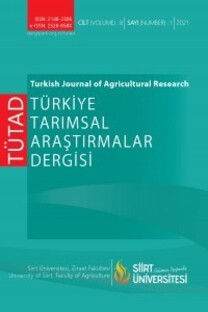Characterization of Multifloral Honeys of Pervari Region with Different Properties
Honey, physico-chemical properties, antimicrobial, pollen identification, artificial neural network,
___
- Abu-Tarboush, H. M., Al-Kahtani, H. A., & El-Sarrage, M. S. (1993). Floral types identifcation and quality evaluation of some honey types. Food Chemistry, 46, 13±17.
- Al-Khalifa, A. S., & Al-Arify, I. A. (1999). Physicochemical characteristics and pollen spectrum of some Saudi honeys. Food Chemistry, 67, 21–25.
- Association of Analytical Communities (AOAC) (2000). Official methods of analysis (17th ed.). Washington, DC: Association of Official Analytical Chemists.
- Bambara, S. B. (1991). 'Using pollen to identify honey'. American Bee Journal, 131(4), pp. 242–243.
- Bogdanov, S. (1997). Nature and origin of the antibacterial substances in honey. Lebensmittel Wissenchard und Technology, 30, 748–753.
- Bogdanov, S., Martin, P., & Lullmann, C. (1997). Harmonized methods of the European Honey Commission. Apidologie, 28, 1–59.
- Bogdanov, S., Ruoff, K., & Persano Oddo, L. (2004). Physico-chemical methods for the characterisation of unifloral honeys: A review. Apidologie, 35, S4–S17.
- Bolchi Serini, G., & Salvi, G. (1990). 'I mieli Lombardi: rizultati di analisi palinologiche'. Ape Nostra Amica, 12(1), pp. 6–9.
- Cohen, W. W. (1995) Fast effective rule induction In Machine Learning Proceedings of the T welfth International Conference. Lake Tahoe California_ Morgan
- Davis, P.H., (1988). Flora of Turkey And The East Aegean Islands, , Suppl., Vol. 10, Edinburgh Univ. Press, Edinburgh.
- Fernández-Gutiérrez, (2006) A. Advances in the analysis of phenolic compoundsin products derived from bees. J. Pharm. Biomed. Anal. 41, 1220–1234.
- Hermosin, I., Chicon, R. M., & Dolores Cabezudo, M. (2003), 'Free amino acid composition and botanical origin of honey', Food Chemistry, 83, pp. 263–268
- Lazarevic´, K.B. Andric´, F., Trifkovic´, J., TeÅ¡ic Zˇivoslav., Milojkovic´-Opsenica, D., (2012). Characterisation of Serbian unifloral honeys according to their physicochemical parameters. Food Chemistry 132 (2012) 2060–2064.
- Louveaux, J. (1985). Les produits du rucher. In Les abeilles et leur e´levage (pp. 165–199). OPIDA.
- Louveaux, J., Maurizio, A., Vorwohl, G., (1978). “International Commission for bee botany of IUBS, Methods of Melissopalinoloji”, Bee World, 59,139-157
- Mohamed, M. A., Ahmed, A. A., & Mazid, M. M. (1982). Studies on Libyan honeys. Journal of Food Quality, 4, 185±201.
- Molan, P. C. (1992). The antibacterial activity of honey. 1. The nature of the antibacterial activity. Bee World, 73(1), 5–28.
- Piana, L., Oddo, L.P., Bentabol, A., Bruneau, E., Bogdanov, S., & Declerck, C.G. (2004), 'Sensory analysis applied to honey: state of the art', Apidologie, 35, pp. 26-37.
- Sancho, M. T., Muniateugi, S., Hudiboro, J. F., & Simal, J. F. (1992). Aging of honey. Journal of Agricuture and Food Chemistry, 40, 134±138.
- Sato, T., & Miyata, G. (2000). The nutraceutical benefit, part II: honey. Nutrition, 16, 468–469.
- Silici S, Sagdic O, Ekici L (2010). Total phenolic content, antiradical, antioxidant and antimicrobial activities of Rhododendron honeys, Food Chem., 121: 238-243.
- Singh, N., & Bath, P. K. (1997). Quality evaluation of different types of Indian honey. Food Chemistry, 58(1–2), 129–133.
- Singh, N., & Bath, P. K. (1997). Quality evaluation of different types of Indian honey. Food Chemistry, 58, 129±133.
- Szczcesna, T. & Rybak-Chmielewska, H. (1993), 'Analiza py_kowa miodo´w (przeglcË›cad literatury)', Pszczelarstwo, 5, pp. 10–11
- The Council of the European Union, 2002. Council Directive 2001/110/EC of 20 December 2001 relating to honey. Official Journal of the European Communities 1(10), 47–52.
- Tuzen, M., Silici, S., Mendil, D., & Soylak, M. (2007). Trace element levels in honeys from different regions of Turkey. Food Chemistry, 103, 325–330.
- Von der Ohe, W. (1994), 'Unifloral honeys: chemical conversion and pollen reduction', Grana, 33, pp. 292–294.
- Wodehouse, R.P. (1935), Pollen grains. Hafner Publishing Company, New York.
- Yilmaz, H., & Kufrevioglu, I. (2000). Composition of honeys collected from eastern and south-eastern Anatolia and effect of storage on hydroxymethylfurfural content and diastase activity. Turkish Journal of Agriculture and Forestry, 25, 347–349.
- ISSN: 2148-2306
- Başlangıç: 2014
- Yayıncı: SİİRT ÜNİVERSİTESİ ZİRAAT FAKÜLTESİ
Kirletilmiş Topraklarda ve Sularda Bitkisel İyileştirme Teknikleri ve Önemi
Girişimci Kadınlar ve İş-Yaşam Dengesinin Sağlanmasında Engel ve Fırsatların Analizi
Characterization of Multifloral Honeys of Pervari Region with Different Properties
Mehmet Emre EREZ, Osman KARABACAK, Lokman KAYCİ, Mehmet FİDAN, Yılmaz KAYA
Siirt İlinde Çayır Mera Alanlarından ve Yem Bitkilerinden Elde Edilen Kaba Yem Üretim Potansiyeli
Nizamettin TURAN, Mehmet Arif ÖZYAZICI, Gülcan YALÇIN TANTEKİN
Muammer KIRICI, Mahinur KIRICI, Mesut IŞIK, Muhammed ATAMANALP
Diyarbakır İli Silvan İlçesi Taban Meralarının Vejetasyon Yapısı Üzerinde Bir Araştırma
Seyithan SEYDOŞOĞLU, Veysel SARUHAN, Ali MERMER
Muammer KIRICI, Muhammed ATAMANALP, Mesut IŞIK, Mahinur KIRICI
